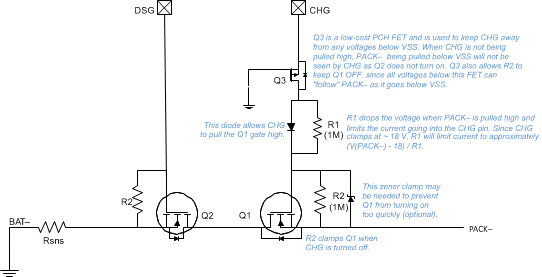SLUSBK2I October 2013 – March 2022 BQ76920 , BQ76930 , BQ76940
PRODMIX
- 1 Features
- 2 Applications
- 3 Description
- 4 Revision History
- 5 Device Comparison Table
- 6 Pin Configuration and Functions
- 7 Specifications
- 8 Detailed Description
- 9 Application and Implementation
- 10Power Supply Recommendations
- 11Layout
- 12Device and Documentation Support
- 13Mechanical, Packaging, and Orderable Information
Package Options
Mechanical Data (Package|Pins)
- DBT|30
Thermal pad, mechanical data (Package|Pins)
Orderable Information
8.3.1.3.1 FET Driving (CHG AND DSG)
Each BQ769x0 device provides two low-side FET drivers, CHG and DSG, which control NCH power FETs or may be used as a signal to enable various other circuits such as a high-side NCH charge pump circuit.
Both DSG and CHG drivers have a fast pull-up to nominally 12 V when enabled. DSG uses a fast pull-down to VSS when disabled, while CHG utilizes a high impedance (nominally 1 MΩ) pull-down path when disabled.
An additional internal clamp circuit ensures that the CHG pin does not exceed a maximum of 20 V.
 Figure 8-2 CHG and DSG FET Circuit
Figure 8-2 CHG and DSG FET CircuitThe power path for the CHG and DSG pull-up circuit originates from the REGSRC pin, instead of BAT.
To enable the CHG fet, set the [CHG_ON] register bit to 1; to disable, set [CHG_ON] = 0. The discharge FET may be similarly controlled through the [DSG_ON] register bit.
Certain fault conditions or power state transitions will clear the state of the CHG/DSG FET controls. Table 8-1 shows what action, if any, to take to [CHG_ON] and [DSG_ON] in response to various system events: